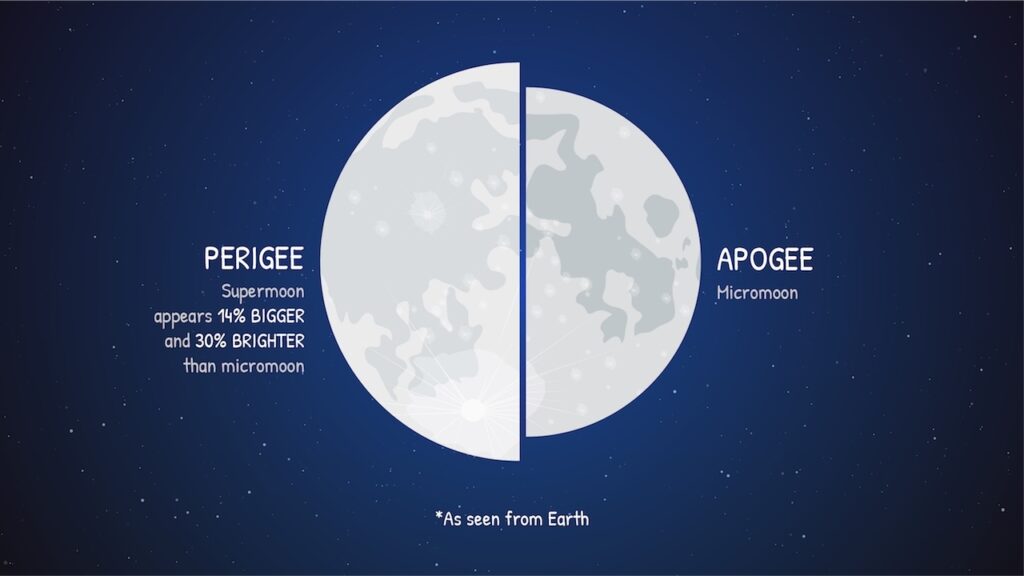Throughout documented human history, the cosmic events that occur in our skies have always inspired awe and amazement. One of these occasions is the enigmatic Super Blue Moon, whose name frequently sparks curiosity and wonder. Let’s examine the nature of this phenomena and the factors that contribute to its widespread appeal.
What is a Super Blue Moon, exactly?

A ‘supermoon’ and a ‘blue moon’ are two astronomical events that combine to form the Super Blue Moon.
Supermoon: A full moon is referred to as a “supermoon” when it is at its closest point to Earth in its elliptical orbit, making it appear larger in the sky. The term “perigee” refers to this moment. In comparison to when it is at its furthest, or the apogee, the moon seems 14% larger and 30% brighter when it is closer to our earth.
Blue Moon: A blue moon isn’t genuinely blue, despite its name. The second full moon of a month with two full moons is referred to by this phrase. Since this occurrence only occurs once every 2.7 years, it is referred to as “once in a blue moon.”
A Super Blue Moon is the second full moon of a calendar month and is a larger and brighter moon when these two phenomena are combined.
You can check this for more information about Super Moon
Why doesn’t the Blue Moon look blue?
The history and culture behind the phrase “blue moon” are more important than the color itself. The moon may occasionally appear to have a bluish hue due to particles in the Earth’s atmosphere, such as after a big volcanic eruption. This occurrence, however, is unrelated to the moon’s phase or orbital location.

Importance in Various Cultures
Over time, several societies have assigned distinct interpretations to cosmic events. There is no exemption for the Super Blue Moon.
Some people consider it to be a time of renewal and transformation because of how uncommon it is. Folklore has it that the second full moon of a month is a good time to wrap up loose ends and prepare for new beginnings. Some astrologers believe it amplifies the gravitational pull on our planet, potentially influencing our emotions and behavior.
Super Blue Moon in Comparison to Other Moon Events
There are other fascinating lunar events than the Super Blue Moon. Further, we have:
Blood Moon When the moon is completely covered by the Earth’s shadow, a total lunar eclipse occurs, giving the moon a crimson colour.
Black Moon This is the second new moon in a calendar month and is the opposite of a blue moon.
What date is the next Super Blue Moon?
Calculations based on lunar cycles are necessary to determine the precise date of the next Super Blue Moon because they happen around every 2.7 years. To help astronomy aficionados keep track, a variety of tools and calendars are available.
Super Blue Moon’s Scientific Relevance

Beyond its cultural and historical importance, the Super Blue Moon has scientific and, to some extent, geological ramifications.
The supermoon’s gravitational pull is stronger since it is closer to Earth, which causes tidal changes. “Spring tides,” or slightly higher and lower tides, could be the result of this. Understanding how the moon impacts our waters has always depended on analyzing these heightened tides.
A super moon is a unique opportunity for astronomers and lunar photographers to investigate and capture the moon’s features with greater clarity because of its larger size. This advances our understanding of the moon’s surface and geology and helps lunar study.
Environmental Implications and Myths
Any rare astronomical event is likely to be the subject of several myths and misconceptions. The idea that a super moon might cause important geological occurrences like earthquakes and volcanic eruptions is a frequent one. Although the moon’s gravitational influence, particularly when it is closer, impacts tides, there is no conclusive scientific evidence connecting the super moon to significant geological disruptions.
Similar to how it might appear that a brighter moon would affect nocturnal creatures, many species have developed adaptations through thousands of years to the moon’s varied brightness throughout its phases.
Astronomy Public Engagement
Events like the Super Blue Moon are crucial for educating the public about science. They spark curiosity about astronomy and inspire people of all ages to observe and interact with the cosmos. During such occasions, observatories, planetariums, and educational facilities frequently host special activities, further igniting a passion for space research.
In Contemporary Media
The Super Blue Moon has appeared in a variety of media, including songs, poems, and movies. It is a favored subject for many artists because of its ethereal beauty and rarity. Such remarks assist to further ingrain it in the public awareness while also highlighting its cultural relevance.
Final Considerations
With improved telescopes and rising interest in space exploration as the 21st century progresses, occasions like the Super Blue Moon continue to blur the boundaries between science and popular culture. It is evidence of people’s insatiable curiosity and our effort to comprehend the enormous cosmos that surrounds us.
Final Thoughts
Like many astronomical occasions, the Super Blue Moon gives us a chance to be in awe of the grandeur of the cosmos. It serves as a reminder of the vastness of the universe and the mysteries that lie above us in the starry skies.
Also checkout our recent blogs at: Blogsroom
if you are interested in IPO related content then make sure to check out ipohunts.
If you are Interested in cricket buzzers and updates then make sure to check out crikzone.
